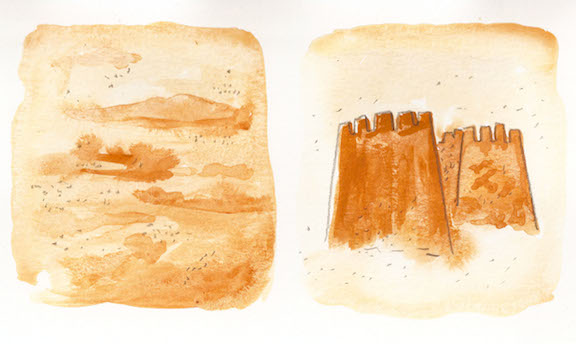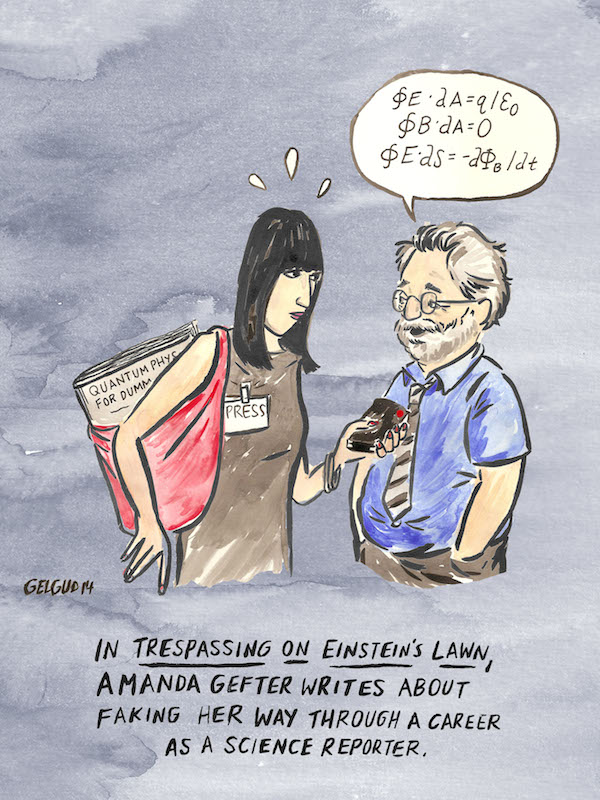Something from Nothing: A Physics and Cosmology Writer Reaches for the Universe
By Nathan Gelgud

In Trespassing on Einstein's Lawn, Samantha Gefter suggests that the universe is simply a redefining of the boundaries of a nothingness that has always been there, like sand castles emerging from an expanse of beach. Illustration by Nathan Gelgud, 2014.
An unsuspecting Amanda Gefter sat in a Chinese restaurant outside Philadelphia at fifteen years old, and the path of her life was altered forever when her dad asked, "How would you define nothing?"
Was this a Zen koan, or a question about theoretical physics? Given her dad's interests, it could have been either. A teenage Gefter who despised math class found herself intrigued. We tend to think of the origin of the universe as the beginning of something new, a moment when something was created. But maybe it was always there. Picture an expanse of beach, nothing but sand. Now picture sand castles on it. Weren't those castles always, in a way, there in the sand? The castle builder has simply redefined the boundaries of the nothingness that was there before.
Seven years after the Chinese restaurant, Gefter is in her early twenties, an aspiring writer stuffing envelopes in an entry-level editorial position in New York. She spots an article in the Times about an upcoming conference at Princeton called "Science and Ultimate Reality." John Wheeler, a theoretical physicist admired by Gefter and her dad, is going to be there. She calls Princeton and says she's a reporter (technically true) who wants to cover the conference. Then she calls her dad and tells him to pack his bags: They're taking a trip.
Gefter's recently published debut book, Trespassing on Einstein's Lawn, is the story of how Gefter turned this "minor deception into an entire career." She parlays her attendance at the conference into her first legitimate assignment as a science writer, crams enough on her given subjects to be knowledgeable, and doesn't look back. Soon, she's earned a master's degree in the philosophy and history of science from the London School of Economics and managed to organize a private debate between Nobel winner David Gross and Leonard Susskind, the inventor of string theory, just so she can write about it. For Gefter, this is like getting together with Bob Dylan and Neil Young for an intimate jam session.
Trespassing on Einstein's Lawn is not just the story of Gefter's career, but also an investigation into theories of the universe and reality. You can see how she's a natural as a writer for popular science magazines, as she makes the ideas accessible and readable without dumbing things down. She tells a professor who warns her that her papers for school should not be too similar in tone to her magazine writing, "I would never make an academic paper that understandable."
She compares Wheeler's theory of the self-creating universe to artist M.C. Escher's hands drawing themselves. She examines whether or not the universe is just an infinite, unbounded homogenous state rearranged into a specific configuration (that's the sand castles theory). She weighs the arguments of the realists versus the anti-realists, whether the world is not made of physical things but of math, and the possibility that there is no reality, only the idea or the appearance or idea of reality. In Gefter's hands, it's fun stuff.
The ideas are big, occasionally mind-bending, and Gefter is good at showing how they threaten to take over everyday life. As a student in London, she has a pest problem in her tiny apartment and wonders if her flat is simply "subject to quantum fluctuations, the sudden but fleeting appearance of rodents from an ever-churning vacuum." Fortunately for readers, she manages to come down to earth, even if she's not sure it's really there. In her lifelong quest to define nothing, she has made something worth reading.

Nathan Gelgud illustration inspired by Samantha Gefter's Trespassing on Einstein's Lawn, 2014.
